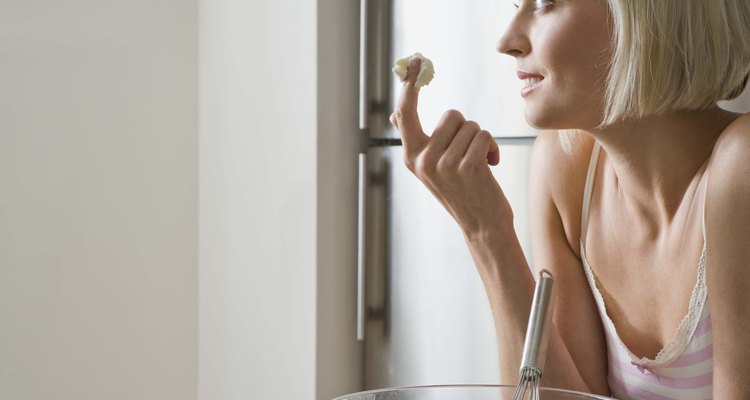
Jupiterimages/Polka Dot/Getty Images
Many vintage cookbooks include recipes for boiled or "seven-minute" icing, a light and fluffy topping for cakes and cupcakes. Although it's heavy on sugar, it contains no butter or other fat, making it a lower-calorie alternative. It's also light and delicate enough for even the daintiest cakes. Basic boiled icing is a snowy white, but it also accepts colors beautifully.
Making Boiled Icing
To make boiled icing you'll need a saucepan, a mixer and an accurate candy thermometer. Most recipes call for sugar and water to be boiled together with a pinch of salt and a small amount of cream of tartar, or another acidic ingredient such as lemon juice. This helps keep the sugar from crystallizing as it boils. While the syrup cooks, whip your egg whites until they're just short of the soft peaks stage. Once your sugar syrup reaches 240 degrees Fahrenheit, whip it into the egg whites in a thin, steady stream. Continue beating until the egg whites form peaks, then add your vanilla and whip for a few seconds longer.
Temperature
An accurate thermometer is important for several reasons. First, the temperature reflects the water content of your syrup. As the water boils away, the percentage of sugar increases. This ensures that your boiled icing isn't too wet, which can cause the colors to run. The hot sugar syrup also cooks the egg whites if it's whisked in at the correct temperature, addressing the risk of salmonella. If you're still concerned about food safety, use pasteurized egg whites for your icing. By cooking the egg whites, the sugar syrup makes a stable foam that won't deflate.
Coloring Your Icing
Boiled icing's pure whiteness, and its affinity for added colors, provide an ideal canvas for an artistic cake decorator. It's best to use concentrated paste colors, which won't dilute the icing. Divide your boiled icing into separate mixing bowls for each color you plan to use, and add your colorings in small increments. You can darken the hue by adding more paste, but you can't take it out if you add too much. For the truest colors, flavor your boiled icing with a professional-style clear vanilla extract, rather than the ordinary brown variety. That preserves the icing's pristine color. Mix your colors ahead of time to judge them correctly, because they'll become slightly muted after resting for a couple of hours.
Using Your Icing
Boiled icing is exceptionally light and spreadable, so it's easy to use. It can be spooned onto cakes and cupcakes, spread with a spatula, or piped from a decorating bag. If you're artistic, lay down a base coat of white or pastel icing and create designs on it using piping bags filled with different colors. Use powdered colors, luster dust, and gold or silver dust to add accents, either for realism or simply to make your decorations prettier. Boiled icing can also be browned with a creme brulee torch, providing another way to add eye-catching details to your cake.
Related Articles
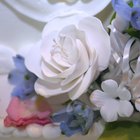
The Best Frosting for Making Roses
How to Make Bakery-Style Whipped Icing
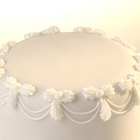
How to Make a White Decorator Icing
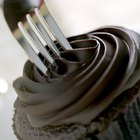
How to Fix Grainy Whipped Ganache

Can You Use Heavy Cream When Making ...
A Substitute for Meringue
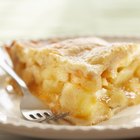
What Can I Substitute for Cornstarch?

What Type of Food Coloring Is Used to ...

How to Substitute Agave Nectar for Sugar
What Frosting Goes Well With Angel Food ...
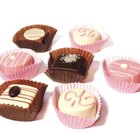
How to Make Petit Fours
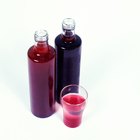
How to Make Sweet Syrup With Fruit Juice

Presweetened Cocoa Powder Substitute

How to Make Cake Frosting Into a ...
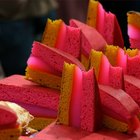
How to Get Hot Pink Colored Frosting
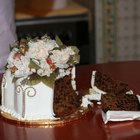
How Early Can You Make a Wedding Cake?

What Can You Use Instead of Powered ...
Can You Freeze Granulated Sugar?
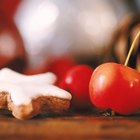
How to Make Shiny Icing for Cookies ...
How to Make Black Icing
References
- The Professional Pastry Chef; Bo Friberg
- The American Woman's Cookbook, Wartime Victory Edition; Ruth Berolzheimer (Ed.)
- King Arthur Flour: Fluffy White Icing: A 7-minute Solution in Less Than 5 Minutes
- Wilton: Tips on Colors
Writer Bio
Fred Decker is a trained chef and prolific freelance writer. In previous careers, he sold insurance and mutual funds, and was a longtime retailer. He was educated at Memorial University of Newfoundland and the Northern Alberta Institute of Technology. His articles have appeared on numerous home and garden sites including GoneOutdoors, TheNest and eHow.
Photo Credits
Jupiterimages/Polka Dot/Getty Images